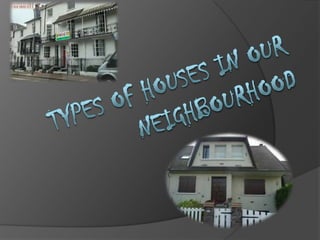Types of houses in our neighbourhood
Download as PPTX, PDF0 likes1,395 views
This document is a school assignment submitted by Siddhi khandelwal of class 4A to her teacher Sajitha maŌĆÖam at Sunbeam school mau on January 7, 2014. It discusses three different types of houses: bungalows, multi-storeyed houses, and mud houses. A bungalow is a type of building whose meaning varies globally. Multi-storeyed houses come in various shapes, sizes and functions and have adapted based on materials, weather, land costs and other factors. Mud houses are made from mixtures of water, soil, silt and clay that harden over time and can be used to construct structures like adobe bricks.
1 of 7
Download to read offline







Recommended
DSKP KSSR PENDIDIKAN ISLAM TAHUN 3 SEMAKAN 2017.pdf



DSKP KSSR PENDIDIKAN ISLAM TAHUN 3 SEMAKAN 2017.pdfNURULSADATULHASLINAA
╠²
DSKP KSSR PENDIDIKAN ISLAM TAHUN 3 SEMAKAN 2017Pencernaan(for student)



Pencernaan(for student)KCC science
╠²
1. Mulut mengunyah makanan dan air liur mengandung enzim amilase untuk mencerna kanji menjadi maltosa.
2. Bolus makanan ditolak ke esofagus dan perut melalui peristalsis.
3. Di perut, jus gaster mencerna protein menjadi polipeptida dan membunuh bakteria.Akaun Chapter 3



Akaun Chapter 3WanBK Leo
╠²
The document discusses accounting concepts including:
1. The recording process which involves journal entries, posting to ledger accounts, and preparing a trial balance from the ledger accounts.
2. Examples of journal entries are provided for transactions of a business called Tadika Malaysia.
3. A trial balance prepared from the ledger accounts is presented, which lists account balances and ensures total debits equal total credits. Dokumen standard kurikulum dan pentaksiran pendidikan jasmani tahun 5



Dokumen standard kurikulum dan pentaksiran pendidikan jasmani tahun 5Razah Dollah
╠²
DSKP pendidikan jasmani tahun 5DSKP KSSM Biologi Tingkatan 4 Dan 5 Kementerian Pendidikan Malaysia



DSKP KSSM Biologi Tingkatan 4 Dan 5 Kementerian Pendidikan MalaysiaAsmahan22
╠²
Kurikulum Standard Sekolah Menengah (KSSM) yang
dilaksanakan secara berperingkat mulai tahun 2017 akan
menggantikan Kurikulum Bersepadu Sekolah Menengah (KBSM)
yang mula dilaksanakan pada tahun 1989. KSSM digubal bagi
memenuhi keperluan dasar baharu di bawah Pelan Pembangunan
Pendidikan Malaysia (PPPM) 2013-2025 agar kualiti kurikulum
yang dilaksanakan di sekolah menengah setanding dengan
standard antarabangsa. Kurikulum berasaskan standard yang
menjadi amalan antarabangsa telah dijelmakan dalam KSSM
menerusi penggubalan Dokumen Standard Kurikulum dan
Pentaksiran (DSKP) untuk semua mata pelajaran yang terdiri
daripada Standard Kandungan, Standard Pembelajaran dan
Standard Prestasi.
Usaha memasukkan standard pentaksiran di dalam dokumen
kurikulum telah mengubah lanskap sejarah sejak Kurikulum
Kebangsaan dilaksanakan di bawah Sistem Pendidikan
Kebangsaan. Menerusinya murid dapat ditaksir secara berterusan
untuk mengenal pasti tahap penguasaan mereka dalam sesuatu
mata pelajaran, serta membolehkan guru membuat tindakan
susulan bagi mempertingkatkan pencapaian murid.
DSKP yang dihasilkan juga telah menyepadukan enam tunjang
Kerangka KSSM, mengintegrasikan pengetahuan, kemahiran dan
nilai, serta memasukkan secara eksplisit Kemahiran abad ke-21
dan Kemahiran Berfikir Aras Tinggi (KBAT). Penyepaduan tersebut
dilakukan untuk melahirkan insan seimbang dan harmonis dari segi
intelek, rohani, emosi dan jasmani sebagaimana tuntutan Falsafah
Pendidikan Kebangsaan.
Bagi menjayakan pelaksanaan KSSM, pengajaran dan
pembelajaran guru perlu memberi penekanan kepada KBAT
dengan memberi fokus kepada pendekatan Pembelajaran
Berasaskan Inkuiri dan Pembelajaran Berasaskan Projek, supaya
murid dapat menguasai kemahiran yang diperlukan dalam abad
ke-21.
Kementerian Pendidikan Malaysia merakamkan setinggi-tinggi
penghargaan dan ucapan terima kasih kepada semua pihak yang
terlibat dalam penggubalan KSSM. Semoga pelaksanaan KSSM
akan mencapai hasrat dan matlamat Sistem Pendidikan
Kebangsaan.
KSSM Biologi bermatlamat untuk memberi pengalaman
pembelajaran bagi murid melibatkan diri dalam proses
memahami konsep biologi, membangunkan kemahiran, strategi
dan pengaplikasian biologi dengan sikap dan nilai saintifik serta
memahami kesan perkembangan sains dan teknologi dalam
masyarakat dimana murid boleh berkomunikasi dan membuat
keputusan berdasarkan bukti saintifik, serta menjadikan murid
sebagai pelajar sepanjang hayat dalam menyediakan mereka
untuk meneruskan pendidikan lanjutan dan kerjaya dalam
bidang STEM.
OBJEKTIF
KSSM Biologi bertujuan membolehkan murid mencapai objektif
berikut:
1. Mengukuhkan minat dan kecenderungan dalam Biologi.
2. Membangunkan pengetahuan, kemahiran, nilai dan
sikap saintifik dalam biologi melalui penyiasatan saintifik.
3. Meningkatkan keupayaan untuk berfikir secara logik,
rasional, kritis dan kreatif melalui proses pemahaman dan
pengaplikasian biologi dalam membuat keputusan dan
menyelesaikan masalah.
Project Report On Bhushan Steel By Mohit Khurana 2003



Project Report On Bhushan Steel By Mohit Khurana 2003Mohit khurana
╠²
The document discusses Bhushan Steel Limited's cash management system and use of letters of credit. It provides an overview of the company, which was established in 1988 and has grown significantly. The company uses a cash management system to control cash inflows and outflows, working with multiple banks. It also uses letters of credit when conducting large transactions to ensure security. The document examines how the cash management system and letters of credit work and their benefits to the company.A research on effectiveness of training & development programme at t. t. min...



A research on effectiveness of training & development programme at t. t. min...Projects Kart
╠²
The document discusses the effectiveness of training and development programs at T.T. Minerals Pvt. Ltd. It begins with an introduction to human resource management and the importance of training employees. It then states the problem as evaluating the effectiveness of T.T. Minerals' training programs. The objectives are to understand the skills needed by employees, evaluate current training programs, understand their impact, and analyze employee satisfaction levels. The scope is the employees of T.T. Minerals and how the study can help the organization. It describes the research design, data sources, sampling methodology, and tools for data collection. Finally, it notes limitations of the study such as constraints of time, cost and sample size.A study on analysis of financial performance on the basis of financial ratioŌĆÖ...



A study on analysis of financial performance on the basis of financial ratioŌĆÖ...Babasab Patil
╠²
A study on analysis of financial performance on the basis of financial ratioŌĆÖsŌĆØ of halasidhanath sahakari sakhar karkhana ltdEffectiveness of training and development among employees in private banks



Effectiveness of training and development among employees in private banksIAEME Publication
╠²
The document summarizes a study on the effectiveness of training and development among employees in private banks in Chennai, India. It discusses the objectives of analyzing training needs and methods to assess effectiveness. The research methodology included a sample of 108 employees surveyed using questionnaires. Data analysis methods like multiple regression, chi-square tests, and factor analysis identified factors that influence job improvement and effectiveness. The study found training to be significantly associated with improving employee knowledge, skills, and job performance.Performance appraisal proces iin godrej (gcpl)



Performance appraisal proces iin godrej (gcpl)aparna4045
╠²
The performance appraisal system at GCPL uses three methods: the forced distribution method, balanced scorecard, and rating system. The balanced scorecard assesses performance from the perspectives of customers, internal business processes, innovation/learning, and financials. The rating system evaluates employees against commitments such as falling short of expectations, meeting expectations, and exceeding expectations. The forced distribution method ranks employees against each other using a forced curve and has the advantages of identifying top and bottom performers but the disadvantage of discouraging collaboration.Biochemistry and biophysics of lens



Biochemistry and biophysics of lensBipin Bista
╠²
This document summarizes key aspects of biochemistry and biophysics related to the human lens. It discusses how the lens generates ATP through anaerobic glycolysis of glucose since it exists in a hypoxic environment. It also describes sugar metabolism pathways including glycolysis, the pentose phosphate pathway, and the sorbitol pathway. Protein metabolism and the role of glutathione in maintaining lens clarity are summarized. Additionally, the document outlines antioxidant defenses in the lens and mechanisms of light transmission, transparency, and the lens's optical properties which allow it to focus light.Entity Framework Interview Questions PDF By ScholarHat



Entity Framework Interview Questions PDF By ScholarHatScholarhat
╠²
Entity Framework Interview Questions PDF By ScholarHatOral exam Kenneth Bech - What is the meaning of strategic fit?



Oral exam Kenneth Bech - What is the meaning of strategic fit?MIPLM
╠²
Presentation of the CEIPI DU IPBA oral exam of Kenneth Bech - What is the meaning of strategic fit? Azure Administrator Interview Questions By ScholarHat



Azure Administrator Interview Questions By ScholarHatScholarhat
╠²
Azure Administrator Interview Questions By ScholarHatMeeting the needs of modern students?, Selina McCoy



Meeting the needs of modern students?, Selina McCoyEconomic and Social Research Institute
╠²
NAPD Annual Symposium
ŌĆ£Equity in our Schools: Does the system deliver for all young people?ŌĆØASP.NET Interview Questions PDF By ScholarHat



ASP.NET Interview Questions PDF By ScholarHatScholarhat
╠²
ASP.NET Interview Questions PDF By ScholarHatChapter 2. Strategic Management: Corporate Governance.pdf



Chapter 2. Strategic Management: Corporate Governance.pdfRommel Regala
╠²
This course provides students with a comprehensive understanding of strategic management principles, frameworks, and applications in business. It explores strategic planning, environmental analysis, corporate governance, business ethics, and sustainability. The course integrates Sustainable Development Goals (SDGs) to enhance global and ethical perspectives in decision-making.Functional Muscle Testing of Facial Muscles.pdf



Functional Muscle Testing of Facial Muscles.pdfSamarHosni3
╠²
Functional Muscle Testing of Facial Muscles.pdfHow to Configure Proforma Invoice in Odoo 18 Sales



How to Configure Proforma Invoice in Odoo 18 SalesCeline George
╠²
In this slide, weŌĆÖll discuss on how to configure proforma invoice in Odoo 18 Sales module. A proforma invoice is a preliminary invoice that serves as a commercial document issued by a seller to a buyer.More Related Content
What's hot (11)
Project Report On Bhushan Steel By Mohit Khurana 2003



Project Report On Bhushan Steel By Mohit Khurana 2003Mohit khurana
╠²
The document discusses Bhushan Steel Limited's cash management system and use of letters of credit. It provides an overview of the company, which was established in 1988 and has grown significantly. The company uses a cash management system to control cash inflows and outflows, working with multiple banks. It also uses letters of credit when conducting large transactions to ensure security. The document examines how the cash management system and letters of credit work and their benefits to the company.A research on effectiveness of training & development programme at t. t. min...



A research on effectiveness of training & development programme at t. t. min...Projects Kart
╠²
The document discusses the effectiveness of training and development programs at T.T. Minerals Pvt. Ltd. It begins with an introduction to human resource management and the importance of training employees. It then states the problem as evaluating the effectiveness of T.T. Minerals' training programs. The objectives are to understand the skills needed by employees, evaluate current training programs, understand their impact, and analyze employee satisfaction levels. The scope is the employees of T.T. Minerals and how the study can help the organization. It describes the research design, data sources, sampling methodology, and tools for data collection. Finally, it notes limitations of the study such as constraints of time, cost and sample size.A study on analysis of financial performance on the basis of financial ratioŌĆÖ...



A study on analysis of financial performance on the basis of financial ratioŌĆÖ...Babasab Patil
╠²
A study on analysis of financial performance on the basis of financial ratioŌĆÖsŌĆØ of halasidhanath sahakari sakhar karkhana ltdEffectiveness of training and development among employees in private banks



Effectiveness of training and development among employees in private banksIAEME Publication
╠²
The document summarizes a study on the effectiveness of training and development among employees in private banks in Chennai, India. It discusses the objectives of analyzing training needs and methods to assess effectiveness. The research methodology included a sample of 108 employees surveyed using questionnaires. Data analysis methods like multiple regression, chi-square tests, and factor analysis identified factors that influence job improvement and effectiveness. The study found training to be significantly associated with improving employee knowledge, skills, and job performance.Performance appraisal proces iin godrej (gcpl)



Performance appraisal proces iin godrej (gcpl)aparna4045
╠²
The performance appraisal system at GCPL uses three methods: the forced distribution method, balanced scorecard, and rating system. The balanced scorecard assesses performance from the perspectives of customers, internal business processes, innovation/learning, and financials. The rating system evaluates employees against commitments such as falling short of expectations, meeting expectations, and exceeding expectations. The forced distribution method ranks employees against each other using a forced curve and has the advantages of identifying top and bottom performers but the disadvantage of discouraging collaboration.Biochemistry and biophysics of lens



Biochemistry and biophysics of lensBipin Bista
╠²
This document summarizes key aspects of biochemistry and biophysics related to the human lens. It discusses how the lens generates ATP through anaerobic glycolysis of glucose since it exists in a hypoxic environment. It also describes sugar metabolism pathways including glycolysis, the pentose phosphate pathway, and the sorbitol pathway. Protein metabolism and the role of glutathione in maintaining lens clarity are summarized. Additionally, the document outlines antioxidant defenses in the lens and mechanisms of light transmission, transparency, and the lens's optical properties which allow it to focus light.Recently uploaded (20)
Entity Framework Interview Questions PDF By ScholarHat



Entity Framework Interview Questions PDF By ScholarHatScholarhat
╠²
Entity Framework Interview Questions PDF By ScholarHatOral exam Kenneth Bech - What is the meaning of strategic fit?



Oral exam Kenneth Bech - What is the meaning of strategic fit?MIPLM
╠²
Presentation of the CEIPI DU IPBA oral exam of Kenneth Bech - What is the meaning of strategic fit? Azure Administrator Interview Questions By ScholarHat



Azure Administrator Interview Questions By ScholarHatScholarhat
╠²
Azure Administrator Interview Questions By ScholarHatMeeting the needs of modern students?, Selina McCoy



Meeting the needs of modern students?, Selina McCoyEconomic and Social Research Institute
╠²
NAPD Annual Symposium
ŌĆ£Equity in our Schools: Does the system deliver for all young people?ŌĆØASP.NET Interview Questions PDF By ScholarHat



ASP.NET Interview Questions PDF By ScholarHatScholarhat
╠²
ASP.NET Interview Questions PDF By ScholarHatChapter 2. Strategic Management: Corporate Governance.pdf



Chapter 2. Strategic Management: Corporate Governance.pdfRommel Regala
╠²
This course provides students with a comprehensive understanding of strategic management principles, frameworks, and applications in business. It explores strategic planning, environmental analysis, corporate governance, business ethics, and sustainability. The course integrates Sustainable Development Goals (SDGs) to enhance global and ethical perspectives in decision-making.Functional Muscle Testing of Facial Muscles.pdf



Functional Muscle Testing of Facial Muscles.pdfSamarHosni3
╠²
Functional Muscle Testing of Facial Muscles.pdfHow to Configure Proforma Invoice in Odoo 18 Sales



How to Configure Proforma Invoice in Odoo 18 SalesCeline George
╠²
In this slide, weŌĆÖll discuss on how to configure proforma invoice in Odoo 18 Sales module. A proforma invoice is a preliminary invoice that serves as a commercial document issued by a seller to a buyer.Helping Autistic Girls Shine Webinar ║▌║▌▀Żs



Helping Autistic Girls Shine Webinar ║▌║▌▀ŻsPooky Knightsmith
╠²
For more information about my speaking and training work, visit: https://www.pookyknightsmith.com/speaking/AI and Academic Writing, Short Term Course in Academic Writing and Publicatio...



AI and Academic Writing, Short Term Course in Academic Writing and Publicatio...Prof. (Dr.) Vinod Kumar Kanvaria
╠²
AI and Academic Writing, Short Term Course in Academic Writing and Publication, UGC-MMTTC, MANUU, 25/02/2025, Prof. (Dr.) Vinod Kumar Kanvaria, University of Delhi, vinodpr111@gmail.comBlind spots in AI and Formulation Science, IFPAC 2025.pdf



Blind spots in AI and Formulation Science, IFPAC 2025.pdfAjaz Hussain
╠²
The intersection of AI and pharmaceutical formulation science highlights significant blind spotsŌĆösystemic gaps in pharmaceutical development, regulatory oversight, quality assurance, and the ethical use of AIŌĆöthat could jeopardize patient safety and undermine public trust. To move forward effectively, we must address these normalized blind spots, which may arise from outdated assumptions, errors, gaps in previous knowledge, and biases in language or regulatory inertia. This is essential to ensure that AI and formulation science are developed as tools for patient-centered and ethical healthcare.How to Configure Recurring Revenue in Odoo 17 CRM



How to Configure Recurring Revenue in Odoo 17 CRMCeline George
╠²
This slide will represent how to configure Recurring revenue. Recurring revenue are the income generated at a particular interval. Typically, the interval can be monthly, yearly, or we can customize the intervals for a product or service based on its subscription or contract. Intellectual Honesty & Research Integrity.pptx



Intellectual Honesty & Research Integrity.pptxNidhiSharma495177
╠²
Research Publication & Ethics contains a chapter on Intellectual Honesty and Research Integrity.
Different case studies of intellectual dishonesty and integrity were discussed.Bß╗ś TEST KIß╗éM TRA GIß╗«A K├ī 2 - TIß║ŠNG ANH 10,11,12 - CHUß║©N FORM 2025 - GLOBAL SU...



Bß╗ś TEST KIß╗éM TRA GIß╗«A K├ī 2 - TIß║ŠNG ANH 10,11,12 - CHUß║©N FORM 2025 - GLOBAL SU...Nguyen Thanh Tu Collection
╠²
https://app.box.com/s/ij1ty3vm7el9i4qfrr41o756xycbahmgAI and Academic Writing, Short Term Course in Academic Writing and Publicatio...



AI and Academic Writing, Short Term Course in Academic Writing and Publicatio...Prof. (Dr.) Vinod Kumar Kanvaria
╠²
Bß╗ś TEST KIß╗éM TRA GIß╗«A K├ī 2 - TIß║ŠNG ANH 10,11,12 - CHUß║©N FORM 2025 - GLOBAL SU...



Bß╗ś TEST KIß╗éM TRA GIß╗«A K├ī 2 - TIß║ŠNG ANH 10,11,12 - CHUß║©N FORM 2025 - GLOBAL SU...Nguyen Thanh Tu Collection
╠²
Types of houses in our neighbourhood
- 1. Introduction Name-Siddhi khandelwal ’é× Class-4 A ’é× Roll no-24 ’é× Subject-E.V.S. ’é× Submitted on-7 of January 2014 ’é× Submitted to-Sajitha maŌĆÖam ’é× School-Sunbeam school mau ’é×
- 3. Types of houses Bungalow ’é× Multi- storeyed house ’é× Mud house ’é×
- 4. Bungalow ’é× A bungalow is a type of building. Across the world, the meaning of the word "bungalow" varies.
- 5. Multi- storeyed house ’é× A building is a man’é× history for a wide made structure with number of factors, a roof and walls standing more from building materials or less permanently in one available, to weather place. Buildings come in a wide variety of shapes, sizes conditions, to land and functions, and have been prices, ground adapted throughout conditions, specific uses and aesthetic reasons.
- 6. Mud house ’é× Mud is a mixture of water and ’éŚ some combination of soil, silt, and clay. Ancient mud deposits harden over geological time to form sedimentary rock such as shale or mudstone (generally called lutites). When geological deposits of mud are formed in estuaries the resultant layers are termed bay muds. Mud is closely related to slurry and sediment. In the construction industry, mud is a fluid material used to coat or adhere together items that dries hard suwhich one form is the common firedch as plaster, stucco, concrete or other similar substances. Mud that is mostly clay, or a mixture of clay and sand may be used for ceramics, of brick, or dried with the inclusion of straw reinforcing to form an unfired adobe brick














